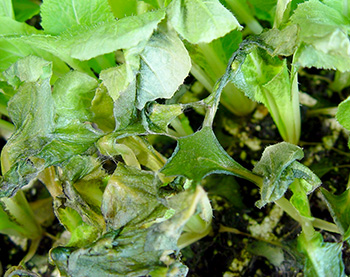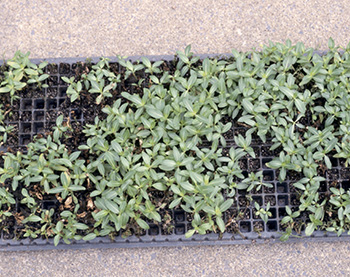Rhizoctonia stem rot occurs on numerous ornamental plant species
Rhizoctonia is a soil-borne fungal pathogen with a wide host range.

This is a busy time of year for Michigan greenhouses, when a wide variety of ornamentals are waiting for shipping or sale. Closely spaced plant material creates an environment favorable for development of several diseases. Rhizoctonia stem blight is one such disease. Every spring Michigan State University Diagnostic Services sees this disease on a variety of ornamentals.
Rhizoctonia often infects the base of the plant causing stem lesions, damping off and root and crown rots. As a soil-borne disease, it is spread by contact with contaminated plant material and media. Therefore, growers should be scouting their plants for the disease and throw out infected plants immediately to prevent the spread of the pathogen. To prevent spread, do not overwater plants and reduce humidity in the greenhouse. As with all diseases, stressed plants will be more susceptible to infections.
To prevent spread, Michigan State University Extension recommends the following fungicides:
- Fludioxonil, (Medallion)
- Pentachloronitrobenzene (Terraclor 400)
- Polyoxin D zinc salt (Affirm WDG)
- Pyraclostrobin + Boscalid (Pageant Intrinsic)
- Thiophanate-methyl (Cleary’s 3336/OHP 6672)
- Captan (captan; note 48-hr REI)
- Azoxystrobin (Heritage 50WG)


Rhizoctonia on Chinese cabbage (left) and Madagascar periwinkle seedlings (right). Photo credits: Gerald Holmes. California Polytechnic State University. Bugwood.org (left); Mary Ann Hansen, Virginia Polytechnic Institute and State University. Bugwood.org (right)
This fungal pathogen can be long-lived because it can produce sclerotia, a long-term survival structure. Therefore, growers who had crops infected with Rhizoctonia should be diligent in sanitizing and cleaning all areas where the pathogen was present after this growing season.
For more information, check out the report on Rhizoctonia solani from MSU Diagnostics Services.
Note: Reference to commercial products or trade names does not imply endorsement by MSU Extension or bias against those not mentioned.



 Print
Print Email
Email




